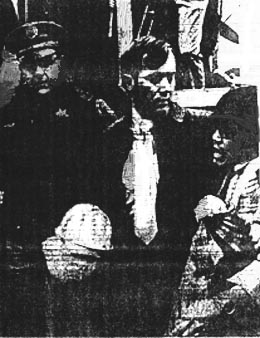On November 2, 1972, a small group of demonstrators jeer and lob mudballs at various city and county officials at groundbreaking ceremonies for the Kingdome, cutting the ceremonies short as a result. There are no injuries; one demonstrator is arrested. Construction of the Kingdome proceeds, and it will open in March 1976.
Slip and Slide
The Kingdome was a controversial idea almost from its conception. Although many local sports fans and business leaders liked the idea of a new sports stadium in Seattle in order to attract a major professional sports team, others were skeptical at its cost and impact on surrounding communities. Bond initiatives to fund a stadium were rejected by King County voters in both 1960 and 1966. The stadium was then made a part of the Forward Thrust package, a comprehensive capital improvement plan approved by King County voters in 1968.
After shopping various sites for the new stadium for a few years, the County finally selected a location near the King Street railroad station. (In 1972, the new stadium-to-be was not yet called the Kingdome, but was more commonly called either the “King Street stadium” or the “domed stadium” in a nod to its domed top.) Excavation work actually began in October 1972, but officials scheduled the official groundbreaking ceremonies for about three weeks later, on November 2, 1972.
It had rained the day before and overnight, and skies were still gloomy and gray as various city and county dignitaries and several hundred spectators slipped and slid through mud at the construction site to join together for the midday ceremony. As they got ready to sing the national anthem, they realized that someone had forgotten to bring a U.S. flag. It went downhill from there.
Earthy Missiles
Also in the crowd were about 25 to 35 Asian American demonstrators. Organized by the University of Washington Asian Student Coalition, this mostly young group was there to protest the impact the stadium would have on housing and small Asian businesses in the nearby International District. After the anthem King County Executive John Spellman (1926-2018) was introduced. As he spoke, the demonstrators in the crowd responded with chants of “Stop the stadium!” But Spellman (fortuitously wearing a hard hat which would soon serve him well) sallied on: “Construction has begun; the stadium will be built. It will be a major asset to all the people in this community. Let’s get on with the building!” (“Stadium Ceremonies Disrupted”).
The demonstrators continued to chant and interrupt other speakers, including Hugh McElhenny (b. 1928), a popular UW and NFL football star. McElhenny was representing the Seattle Kings, a group trying to attract a pro football franchise to Seattle, and held a helmet and a football while he gave his remarks. But he also eyed the demonstrators and riposted “I’d never make it as a politician. As a football player, when things get tough you just go get them” (“Stadium Ceremonies Disrupted”). The demonstrators dared him to try.
Spellman then held up a faux-gold home plate that was to be placed in the ground as part of the ceremony. Someone threw a mudball at it. Then more mudballs flew. At least four or five officials, including Spellman and County Commissioner John O’Brien, were hit by the earthy missiles. Spellman quickly planted the gold home plate in the ground, but plans to have to have the symbolic first ball thrown over it were canceled. Also axed were plans to have Spellman kick a field goal through temporary goal posts. Instead the ceremony came to an abrupt and ignominious end.
Holding His Ground
After the ceremony the demonstrators confronted Seattle City Council President Liem Tuai (1925-2003) -- also an Asian American -- and accused him of selling out to the Establishment. But Tuai held his ground. “I believe in the stadium,” he answered. “I think it has to be built. I think the people of Seattle want it to be built and I represent all the people of Seattle” (“Stadium Ceremonies Disrupted”).
Construction delays and more citizen dissent continued through the Kingdome’s construction. It finally opened in a gala ceremony on March 27, 1976. But the controversy about the Dome never really stopped, and it was imploded in a spectacular show on March 26, 2000. Today the site is home to another stadium, Qwest Field.

